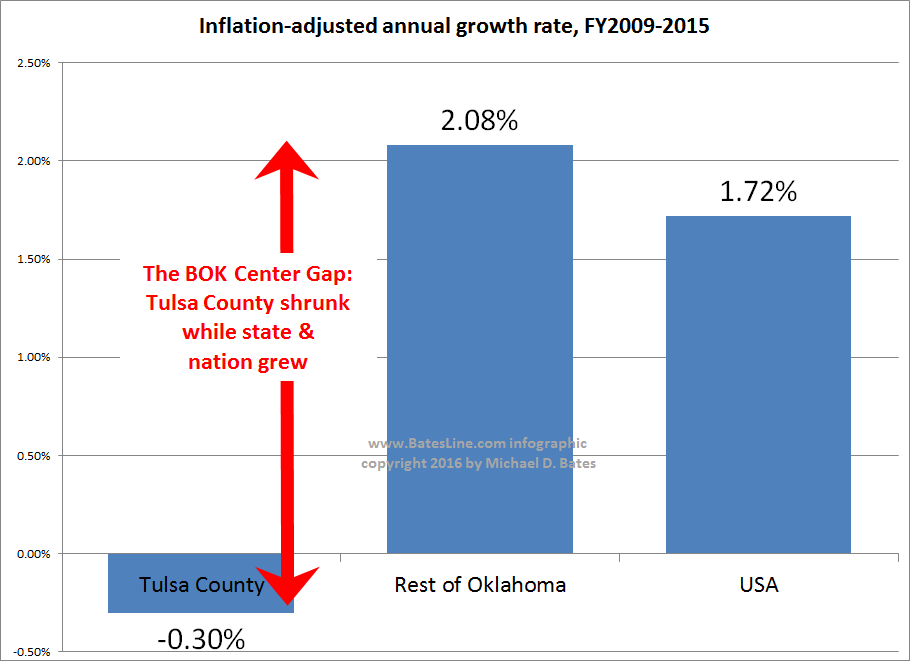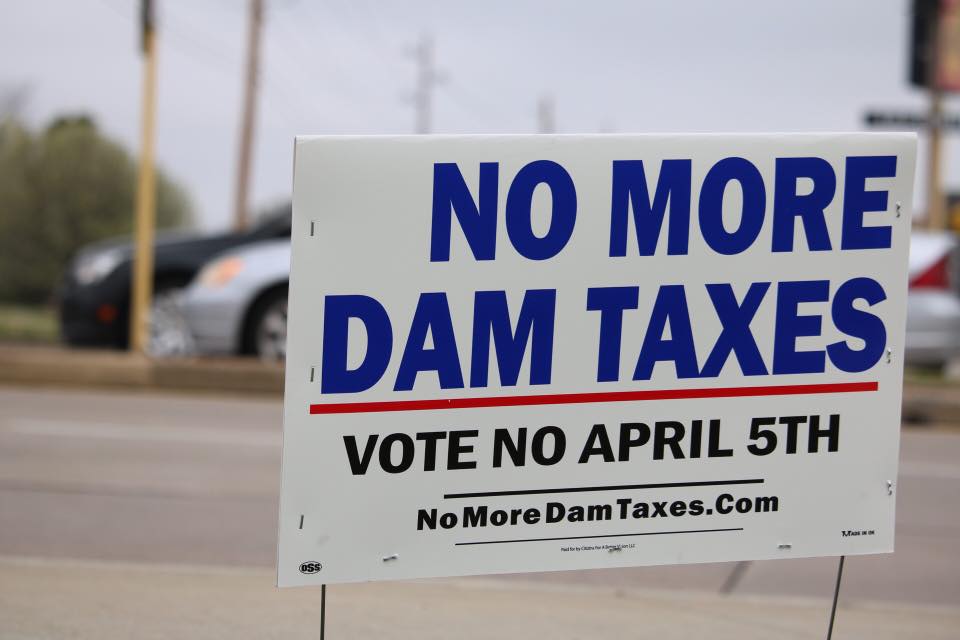Tulsa Vision 2025: March 2016 Archives
Back in 2003, as Tulsa was emerging from a recession, local leaders made some extravagant promises to a desperate populace. In the spirit of Rahm Emanuel's dictum -- "Never let a crisis go to waste" -- our Mayor and County Commissioners persuaded Tulsa County voters that these promises would come to fruition if only they'd raise their sales tax rate for the next 13 years.
I'm not just talking about the promises to build specific projects. Most of the projects were completed as promised, but not all. We never did get that Native American Cultural Center. A vacant lot at 11th and Riverside still awaits the promised Route 66 Museum. The First Street Lofts remain under construction. Nine years after the centennial, we're still waiting for Centennial Walk historical markers. Vision 2025 funding for the three promised dams was supposed to be supplemented by federal funds or, failing that, surplus revenue raised by the Vision 2025 tax. Instead, Tulsa hired a starchitect to build the arena and overspent the budget; between the arena and the compensation paid to the suburbs for the arena overage, the surplus was depleted. Not only are the dams not done, but we're still awaiting completion of feasibility studies and permits.
But I digress. Let me focus your attention on Vision 2025's broken promise of economic development. It's important because the same promise is being made for the dams and other projects in the Vision Tulsa package on next Tuesday's ballot.
The pitch went like this: "You may never attend a concert at the arena, you may not benefit directly from any of these projects, but if we vote yes on Vision 2025, the Tulsa region will attract so much convention and tourism business, we'll grow so many new jobs, that we'll have plenty of sales tax revenue to spend on fixing our streets, hiring more police officers, reopen the city pools, mow the medians, and turn the expressway lights back on."
Substitute "dams" for "arena" and "Vision Tulsa" for "Vision 2025," and you'll hear the same argument being made today.
You want an example? Here you go:
THEN:
"Vision 2025: Plan envisions modernized center," Tulsa World, August 17, 2003 (emphasis added):
But officials across the nation say convention centers, mainly, and events arenas, partly, show a direct profit only rarely, otherwise more would be built by the private sector.Instead, such facilities are built as spending magnets that draw hordes of people to a destination where they drop additional dollars into the economy, spurring development and increasing sales tax revenues.
LaFortune said it's that spending by people, whether they are headed to a trade show or rock concert, that helps pump life back into a community. The mayor stressed that when businesses are thriving, sales tax revenues grow and a city has more funds to fix streets and sewers, improve parks and programs, and pay salaries for police, fire and municipal employees.
NOW:
"Tax idea floated," Tulsa World, July 1, 2014:
Councilor Blake Ewing, who hosted Monday's meeting for his district at the First Presbyterian Church, said he agreed with Bartlett but would go even further in pursuing city investments that would increase sales-tax receipts."When your revenue and inflation are not in line, you end up having to do more with less and less and less," Ewing said. "We need to increase the revenue."
In 2002 and 2003, city budgets were under pressure. The telecom bubble had burst, and Tulsa had lost thousands of high-tech jobs. 9/11 had hurt our city's biggest employer, American Airlines. The city had to close 18 of our 22 public pools, unless private donors could be found to keep them open. The city switched off the street lights on our expressways and let the medians and rights-of-way get overgrown. Then-Mayor Bill LaFortune declared that we had to do something.
We were promised in 2003 that if we passed Vision 2025, our economy would grow so much that we'd have enough additional revenue to pave streets and hire more police officers and re-open our closed city pools.
If Vision 2025 made our economy grow, why are we now being asked to increase our permanent operating sales tax rate by 17.25% (from 2% to 2.345%) to fund basic police and fire coverage and street maintenance? Why are we demolishing rec centers and pools? Vision 2025 built a lot of pretty things, but it didn't grow Tulsa's bottom line.
Was the promise fulfilled? Let's look at the numbers.
According to the February 2016 report, Vision 2025 has extracted $673,530,955.45 from the local economy. Nearly all of that has been spent on projects or on debt service on the money the Tulsa County Industrial Authority borrowed to build the projects sooner. The projected total when the tax expires at the end of the year is $732,340,192.06. A little bit of that was spent on streets and basic infrastructure, but most went to projects that were supposed to boost our economy, indirectly growing our sales tax revenues.
Based on that report, Tulsa County's taxable sales rose from $7.9 billion in FY2005 to $10.4 billion in FY 2015. That's an annualized rate of growth of 2.74%. But the cost of living rose an average of 1.89% per year over the same period. In inflation-adjusted dollars, Tulsa County's retail receipts grew at a rate of 0.84% per year. But over the same period, US GDP in inflation-adjusted dollars grew at a rate of 1.475% per year. So the US economy grew almost twice as much as the Tulsa County economy during the Vision 2025 period. (Historical CPI values came from Table 24-C of the February 2016 CPI Detailed Report.)
"Apples to oranges!" you say, comparing sales taxes to GDP. All right, then, let's look at state sales tax revenue over the same period, which increased from $35.0 billion in FY2005 to $54.0 billion in FY2015. Retail sales in Oklahoma minus Tulsa County grew at an annualized rate of 4.88%. Adjusted for inflation, retail sales in the rest of Oklahoma grew at a rate of 2.93% per year, over three times as fast as the Tulsa County Vision 2025 economy.
"No fair!" you object. "The BOK Center didn't open until August 2008!" So let's look at the change from FY2009 to FY2015. Tulsa County taxable sales rose by an average annual rate of 1.24% over that period, but Tulsa County taxable sales actually fell in inflation-adjusted dollars by an average of 0.30% per year. Meanwhile, taxable sales in the rest of the state rose by a raw average of 3.66% per year or 2.08% adjusted for inflation.

I'm probably more surprised at this result than you are, but there you have it. Perhaps the falloff after the opening of the BOK Center represents the bursting of the building bubble created by early funding and completion of Vision 2025 projects. The construction was done, and the construction jobs were gone. (Here's a spreadsheet with the data, if you want to check my work.)
Tulsa can't afford the kind of "growth" we've had since Vision 2025 passed and the BOK Center opened its doors. It's a fool's errand to try to generate revenue for basic infrastructure indirectly by by raising taxes to build amenities in hopes of generating economic growth. Expensive amenities don't stimulate the local economy any more than building a pool in your backyard stimulates your personal economy. The builders make their money, create a few temporary jobs, but when the construction is over, the jobs are gone. You've got a nice amenity, but also a new maintenance obligation that cuts further into your funds.
Let's not make the same mistake again. Vote no on the mislabeled Tulsa Proposition 3 for "Economic Development" next Tuesday, April 5, 2016.
HELP SPREAD THE WORD:
Email citizensforabettervision@gmail.com to get an attractive "No More Dam Taxes" sign placed in your yard. A yard sign alerts your neighbors that there's an election and reminds them that $127 million for low-water dams (not including interest on bonds) is the biggest item in this package.
We also need people to fund last-minute social media and other voter contact efforts. Use that same email address to send money via PayPal. Any amount helps. (Larger amounts help more.)

